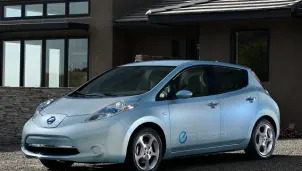2011 Nissan LEAF Review
Nissan Leaf – Click above for high-res image gallery
Nissan has gone into a back room, pulled out its Ouija board and decided that the time is right to make a huge bet. The Japanese automaker, along with its partner Renault, wants to be the world leader in pure electric vehicles. Even though you can go buy an Altima hybrid right now, the company didn't develop its own gas-electric technology (the sedan uses Toyota tech). This time around, Nissan believes the future belongs to vehicles without an internal combustion engine (ICE) and is preparing to put its own foot forward. It's way too early to know for sure, but Nissan's gamble could pay off handsomely. Toyota leads the hybrid race, General Motors and others are adding plugs to vehicles with liquid-fueled engines, but no major automaker has claimed the pure EV pole position. If everything goes right, Nissan will be that automaker.
The flagship vehicle for the automaker is, of course, the Leaf EV hatchback, which was unveiled in August and recently made its North American debut in Los Angeles. We were on hand to take a Leaf mule out for a short (very short) spin and heard directly from Nissan how this unique-looking EV will secure Nissan's place in the auto industry as tremendous changes take place in the coming years. Follow us after the jump to learn about Nissan's wager and find out if the Leaf has got the potential to (silently) propel the company to the top.
Photos copyright ©2009 Sebastian Blanco / Weblogs, Inc.
The short answer is, yes, the Leaf is a promising piece of machinery and fans of pure EVs can safely celebrate what Nissan is doing here. Drivers who need to drive long distances can stick with ICEs for now; those who like the idea of battery power but don't want to rely solely on electrons should consider the forthcoming Chevrolet Volt. For battery electric vehicle (BEV) fans who want a major brand name plastered on their zero-emission vehicle, there are a small handful of options: the Ford Focus BEV, Renault's varied line-up, and the Nissan Leaf.
Like the competition, the Leaf offers about 100 miles of range and a decent recharge time – you can get an 80-percent quick charge using a special charger in 30 minutes, while a more common 200V outlet will need about eight hours to fully charge the lithium ion battery pack. These numbers don't make sense for everyone, but Nissan doesn't care. All that matters is that they make sense for enough people.
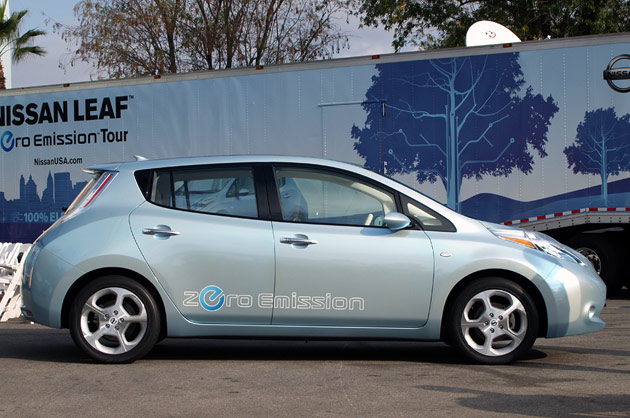



As reported previously, Nissan believes that plug-in vehicles will make up ten percent of the new car market by 2020. By considering who makes up this ten percent, Nissan contends that range anxiety and other worries that BEV critics throw out aren't a big deal. Nissan CEO Carlos Ghosn told Autoblog that since Nissan will lease the batteries at a competitive price, the customer experience will be simplified, leading to plenty of interested buyers in that first ten percent of the market. Then, in 2020, when automakers are looking to expand to 11 percent and beyond, battery technology will have advanced far enough beyond where it is today. The increased range and reliability will be attractive to a new set of electric car buyers. Then the market expands, the technology gets even better, and we rinse and repeat.
For the serious plug-in fans, Ghosn said it is "possible" that his company will sell gliders (car minus powertrain) or the entire car with batteries, but he made it clear that this is unlikely. Offering anything other than the leased batteries, he said, might confuse people and wipe out the work that the company plans to do in promoting the Leaf as a simple decision. And Nissan is trying to introduce the Leaf as a simple, affordable electric vehicle.
See. Learn. Drive.
The Leaf's next year looks like this: the public tour that kicked off in Santa Monica this past weekend continues through North America until February. Nissan PR calls this the "See" portion of the rollout. The next phase will be a series of technological displays across the U.S. where EV fans and curious passersby can learn about the batteries and the electric drivetrain. The details of this tour are still being worked out. Phase three will be a ride and drive tour, Nissan's first in about five years, that will hit two dozen markets during the summer and fall of 2010. This will be the first chance for the general public to get behind the wheel of the Leaf. Speaking of which...
Behind the Wheel
The stationary show car that will be making the rounds in the coming moths is how the Leaf looks. The modified Versa that Nissan brought to LA is how it drives. Nissan put the Leaf's electric powertrain into the Versa, known as the Tiida in Japan, because the two cars are about the same size. Before the Versa mule, Nissan tested the powertrain in a Cube body, which we drove in May. A lot of media representatives and stakeholders were in Los Angeles to drive this vehicle, and Nissan shuffled everyone through by shrinking the size of the driver loop to just four-tenths of a mile. Our total time behind the wheel: 90 seconds.

In the short parking lot course, there were two straight-aways, which allowed us to punch the car and discover that, while the Leaf powertrain doesn't accelerate like a Tesla Roadster, it's got more than enough get-up-and-go for a standard family car, even with four adults on board. Considering the Leaf will cost something like a third or a fourth as much as a standard Roadster, we think the car will cause a fair share of EV grins once it's unleashed into the wild. After getting up to speed, we found the regenerative brakes felt great. While Nissan is still fine-tuning the system for production, they grip solidly whether you're going fast or slow, gently applying pressure or hitting them hard. Knowing how difficult it can be to get regenerative brakes to provide the proper feedback while also providing a "normal" driving experience, Nissan is certainly on to something here. There's also a benefit to the buyer because the regenerative system means the brake pads will need to be changed less frequently than they would on a traditional vehicle.
Ghosn claims the Leaf "comfortably seats five," but we were not able to actually sit in the vehicles. Based on the Tiida, which has dimensions that are close to the Leaf's, we think that if you want to ride with five, pick a smaller friend to ride on the hump.
Outside looking in
More than one person has compared the Leaf's backside to the rear end of certain curvaceous celebrities. In person, the Leaf doesn't look all that bootylicious. It's not sparse and sleek in back, but the curves don't distract from the overall gracefulness. It looks good, and if Nissan wants to get ten percent of the people to fall in love with EVs, then providing a distinct shape is a good idea (see: the Prius).
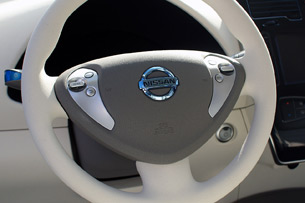


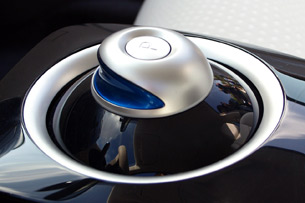
Two Leaf prototypes exist: One current touring the U.S. and another that's still in Japan. We can easily imagine that the tour vehicle will be ogled non-stop over the next year. The stretched head- and taillights, the two plugs hidden under a front panel (not exactly the most convenient location, admittedly), and the long overhang over the rear window all make it clear that this is not your average car.
Charging up the car, charging up the roads
The first generation of Leafs, the 2011 Model year, will have 3.3 kW charging systems. After that, charging at 6.6 kW will be an option (price: undisclosed), as will high-speed charging. People who want the 6.6 kW charging option shouldn't wait until the 2012 MY Leafs, since the first models will be upgradeable. This bit of news pleased the Plug In America advocates we talked to in Dodgertown.
While Nissan expects that the cost of a home charger in the garage will be around $500 to $800 for the hardware, there's a lot of work to be done to get communities plug-in ready. Nissan has been working harder (in public, anyway) than any other OEM to form partnerships to get quick charging infrastructures built in time for the first EVs to hit the market. To that end, Renault-Nissan has signed 35 MOUs with governments around the world.


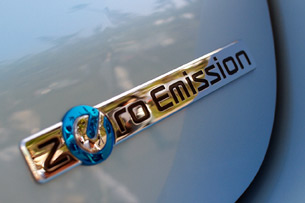

While Nissan is making a big push for this help now – and for subsidies that make buying a plug-in car cheaper for individuals – Ghosn believes that government help will only be required for the first three to five years. After that, the market will supply the demand and economies of scale will make sure the cars are affordable. Until then, government aid not only helps sell cars, but it also helps Nissan figure out where to invest its limited resources. Ghosn said that his company is not out soliciting government help, but is certainly rewarding governments that promote plug-in vehicles by focusing their efforts in those places where there is EV support.
This is the Nissan plug-in vehicle strategy in a nutshell: find the fans, give them an EV that they can afford in places where they can easily recharge, and build from there. The Leaf will be followed by a zero-emission Nissan light commercial vehicle and a pure-electric Infiniti compact luxury car. These vehicles show off Ghosn's belief that pure EVs are the way to go – no plug-in hybrids, no conventional hybrids, no hydrogen, no compromises. And it should be interesting to see if this strategy works.
Photos copyright ©2009 Sebastian Blanco / Weblogs, Inc.
Our travel and lodging for this media event were paid for by the manufacturer.
Autoblog accepts vehicle loans from auto manufacturers with a tank of gas and sometimes insurance for the purpose of evaluation and editorial content. Like most of the auto news industry, we also sometimes accept travel, lodging and event access for vehicle drive and news coverage opportunities. Our opinions and criticism remain our own – we do not accept sponsored editorial.


















































